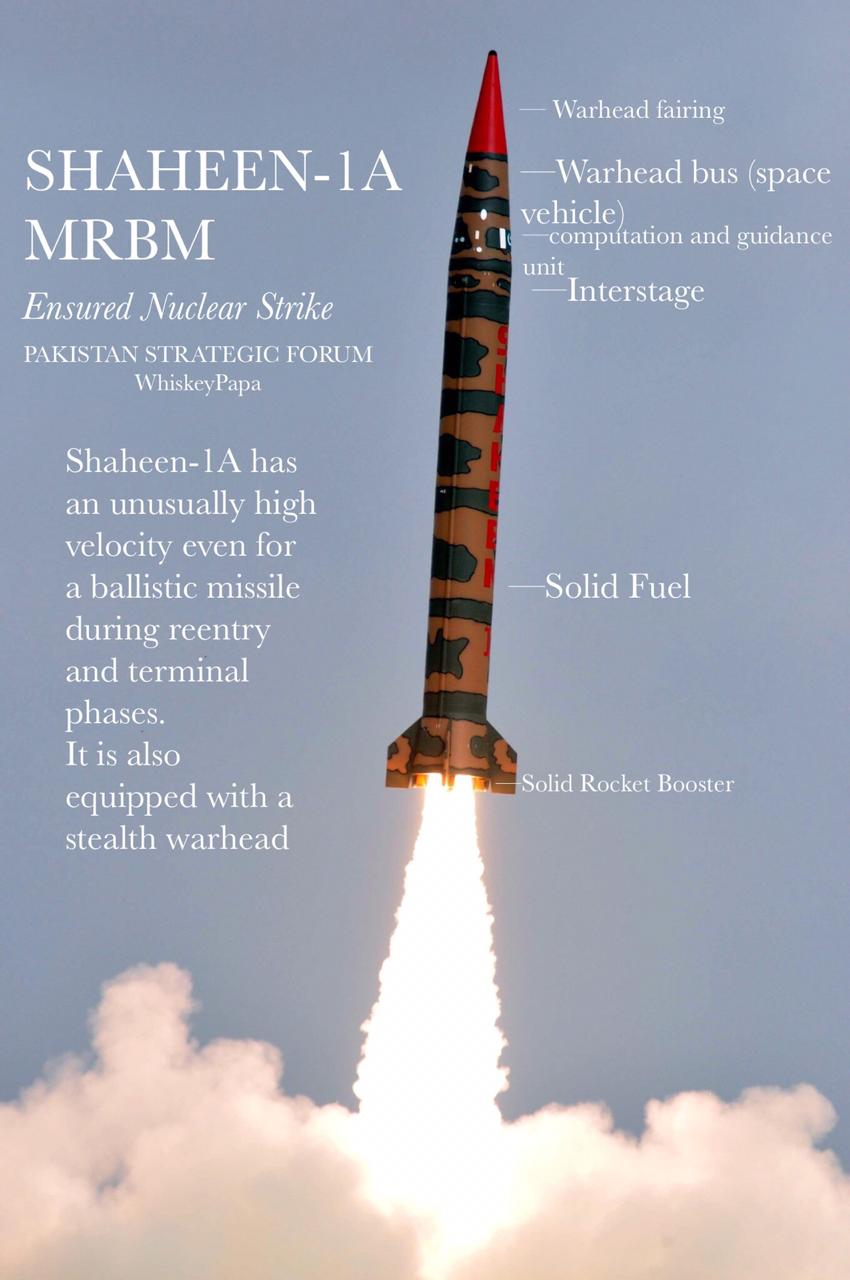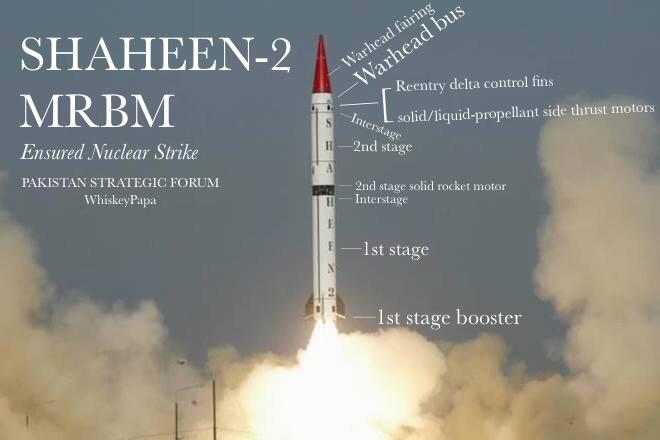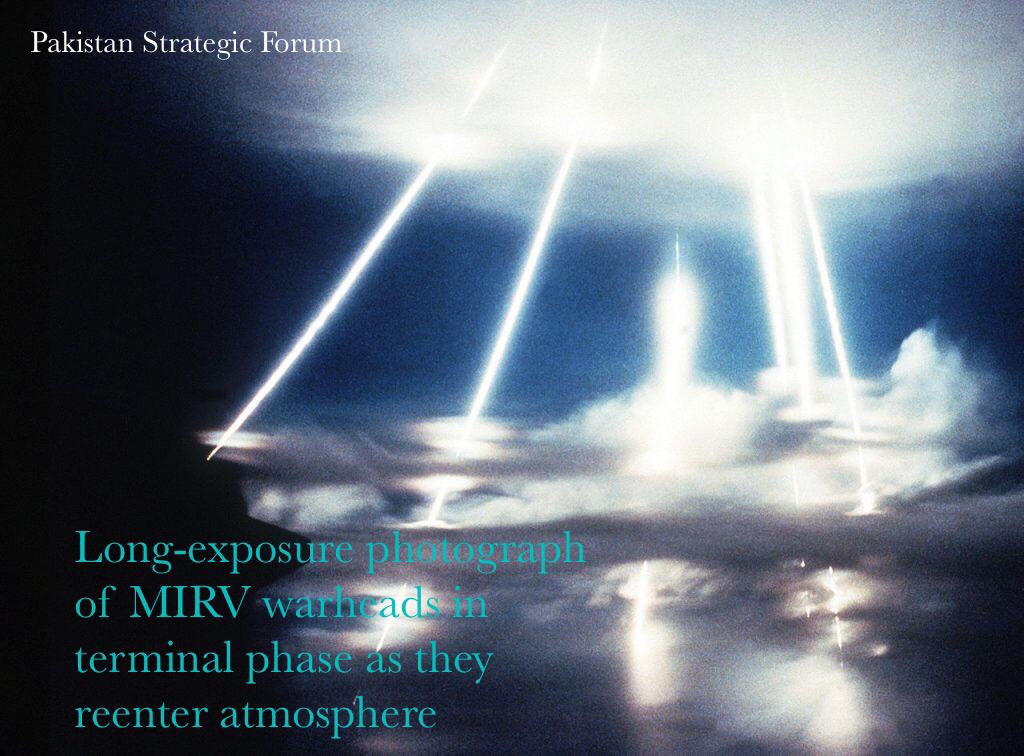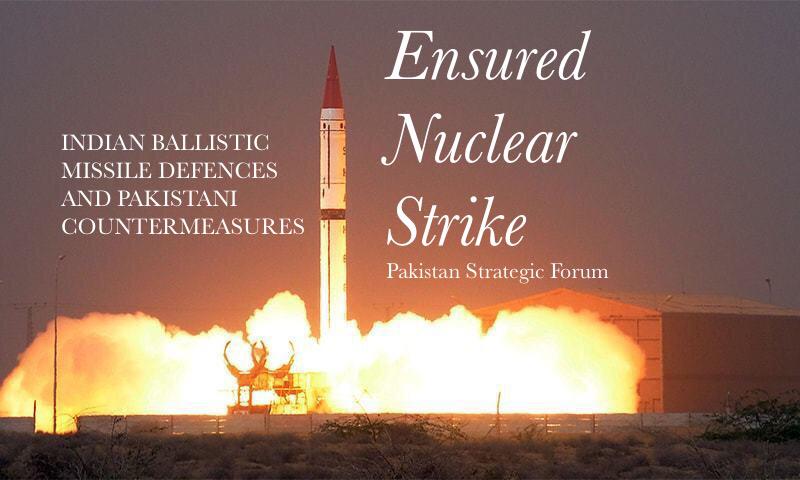ghazi52
PDF THINK TANK: ANALYST

- Joined
- Mar 21, 2007
- Messages
- 102,833
- Reaction score
- 106
- Country
- Location
Ensured Nuclear Strike: Indian Ballistic Missile Defense and Pakistani Countermeasures
By
Admin PSF
August 27, 2020
https://vk.com/share.php?url=https:...issile-defense-and-pakistani-countermeasures/

Indian Ballistic Missile Defense
>Ballistic Missile Defense encompasses all efforts employed to stop a tactical or strategic attack by a ballistic missile, but usually BMD is concerned with missiles armed with nuclear weapons.
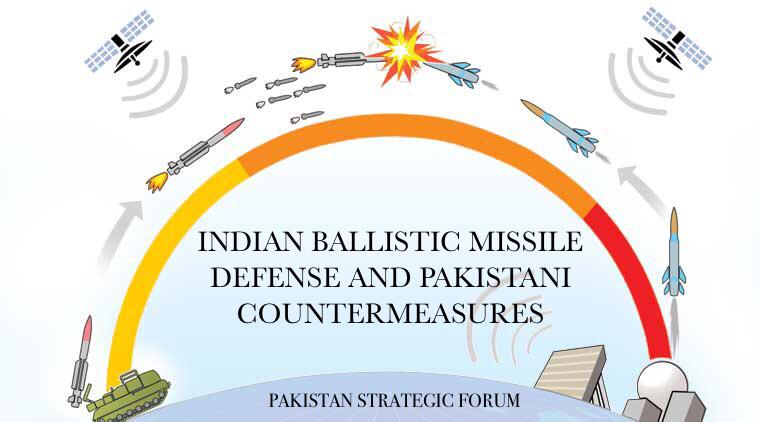
Anti-Ballistic Missile Defense System
>A ballistic missile is a missile which follows a ballistic trajectory (i.e. is propelled via rocket to very high speeds for a short time such that it leaves the atmosphere, makes an arch and follows a suborbital trajectory in space and then falls back to earth and hits the target).

Ballistic Missile Flight Phases
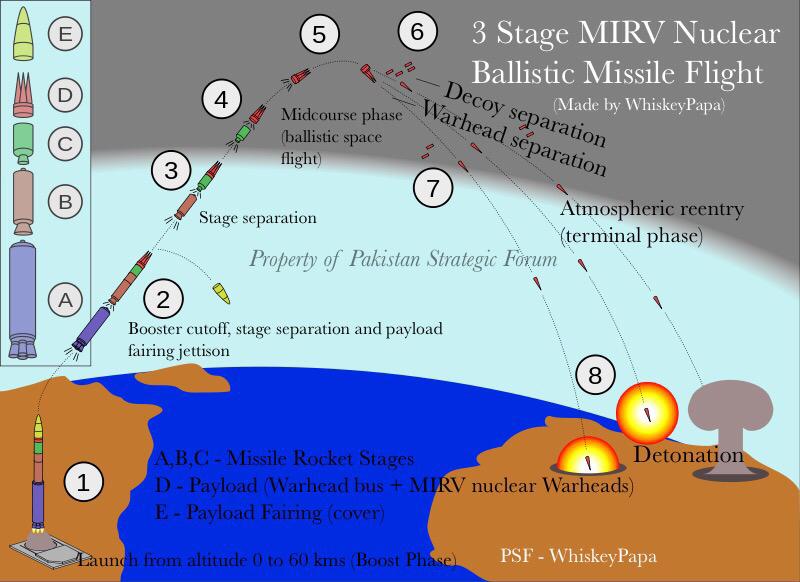
>BMD countermeasures are incorporated in those ballistic missiles which are designed to penetrate a ballistic missile-hostile environment and these counter, fool, and target BMD systems to ensure nuclear payload delivery.
India has over the past two decades invested heavily in both procuring BMD systems as well as significant investments in the research & development of various indigenous ballistic missile defense systems in an attempt to deploy a layered BMD system so that a Pakistani nuclear strike could be deterred, denied or destroyed. This tips the strategic balance in the region.
The whole aim of strategic balance and parity is to ensure nuclear deterrence and a deterrent for war. Thus if you show any weaknesses in your nuclear deliverance systems the enemy might be emboldened to strike you first, if they believe you won’t strike back/won’t be able to strike back/your strike can be stopped by BMD. India has over the past years tried several times to shift the strategic balance in their own favour. Pakistan has always responded overwhelmingly effectively and has tried to keep the strategic balance in check.
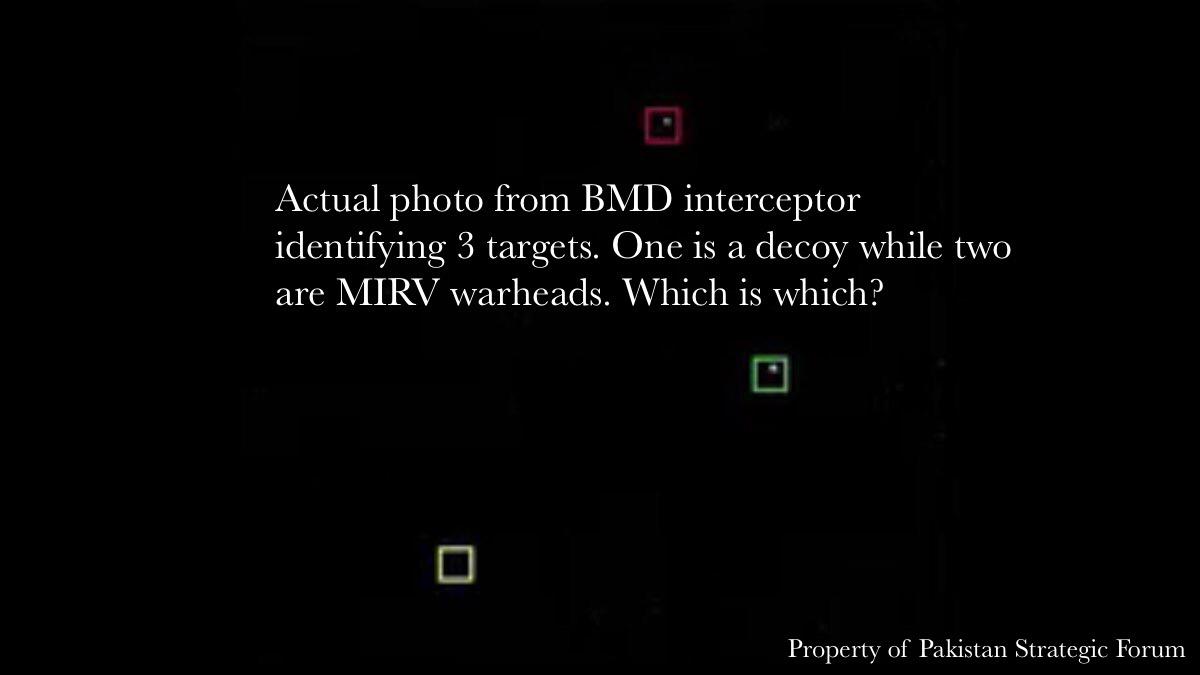
BMD Interceptor
Even after significant investments in the range of billions of dollars and over 2 decades India has been unable to deploy even rudimentary Ballistic Missile Defense.
The Interception and destruction of an incoming ballistic missile warhead from space has been a field of interest throughout the cold war with the two world superpowers at the time (USSR & USA) developed and deployed many different types of BMD systems with various levels of success, none of them guaranteed. As the reentry vehicle carrying a nuclear warhead travels at Mach 20-25 and there are mere seconds between reentry and detonation.
The three different types of BMD systems target the ballistic missile in its three phases of flight- the boost phase (warhead is flying to space on a ballistic trajectory via a missile’s rocket engine), the midcourse phase (the warhead has separated from the main missile body and is cruising through space) and the terminal phase (warhead is falling down the path to its target and is reentering the atmosphere at speeds approaching Mach 23).
Targeting the missile in its boost phase is unfeasible as you would need to get close to the launch platform which is probably deep inside enemy territory.
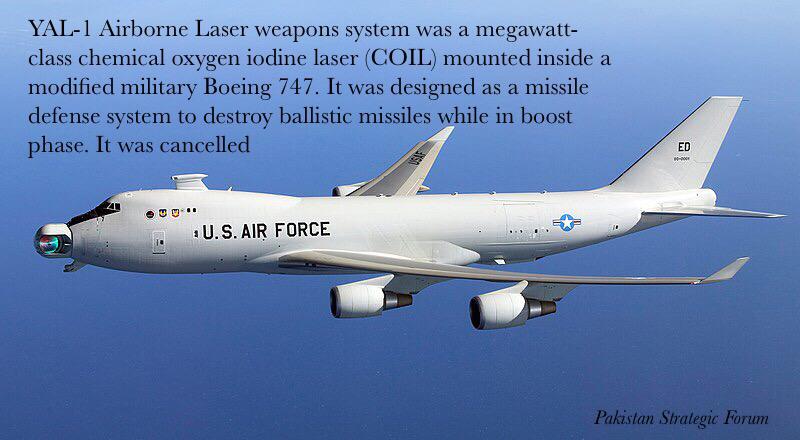
YAL-1 Airborne Laser Weapon System

Mid-course interception is relatively easier but more susceptible to deception measures as modern missiles employ various decoys shaped like the warhead and also have various other countermeasures (explained below). The midcourse interceptor missiles are much heavier (as they have to carry a kill vehicle into space), more technologically complex and very expensive to build and maintain. While most BMD systems are ground-based, the Americans have developed the Aegis Defense System which is a ship-based missile defense system and is a mid-course interceptor for medium range missiles, although the ship must be in the right azimuth, range and location.
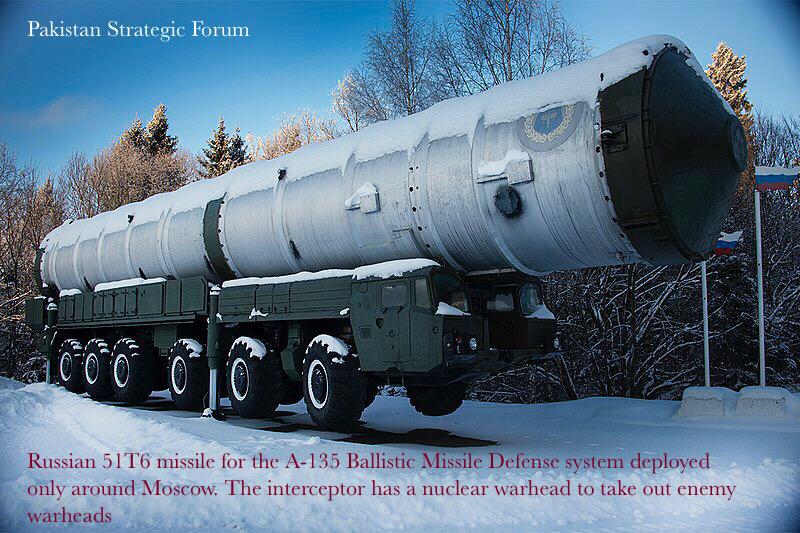
Terminal phase interception has from the start been identified as the most feasible method thus far and the Americans and Russians have designed various terminal interception missiles, starting from interceptor missiles with nuclear warheads themselves that detonated near the warheads and destroyed them and then moved on to standard High Explosives, tungsten rods or hit-to-kill technology (kinetic kill: striking the warhead with an object at high relative velocity, thus destroying it) as interception technology got better.
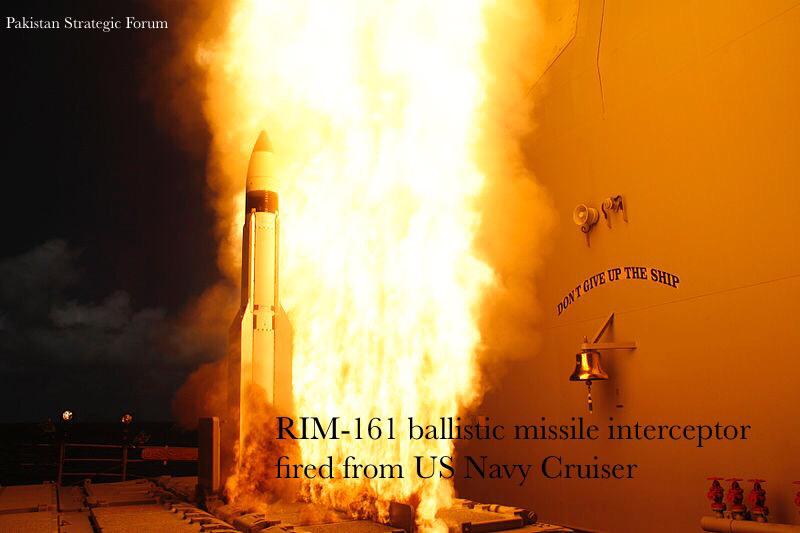
RIM-161 Ballistic Missile Interceptor
But, even the best interception missiles available today in the world have only a 52% chance of interception. The American NORAD command therefore advises firing 3-4 interceptors for every ballistic warhead heading its way. Even still, the effectiveness of these systems is debatable even after the US has spent over half a trillion dollars and 40+ years trying.
The BMD concept itself is flawed because of the numbers game. Interceptors are much more expensive, technologically complex and hard to maintain and operate than ICBMs/IRBMs/MRBS/SRBMs/TBMs and you need 4 for each and even then interception is not fully garaunteed. This is the reason why USSR & USA built thousands of nuclear bombs and missiles during the cold war as it was not feasible for even a world superpower to make and deploy such numbers of BMD interceptors.
India, however, neither has the amount of interceptors nor the technological superiority of either American or Russian BMD systems.
India has just begun work on a mid-course interception missile based on its anti satellite missile test which occurred last year, but this system would be very expensive, difficult to develop and will take at least 15-20 years to operationalise and would still be unfeasible, unpractical, expensive and in too low numbers for any real deterrence.
INDIAN BMD
India currently has two different BMD terminal interception systems in testing after its bid to acquire the Arrow-2 BMD systems from Israel was vetoed by Washington in 2002.
Both systems are designed by the Indian Defense Research and Development Organization (DRDO).
These systems are namely the Prithvi system and the Ashwin system which started development in 1999 and may come into operation in 2024, both to be employed in small numbers around the Indian capital of New Delhi and the surrounding strategic assets.
The two-tiered ballistic missile defense system consists of the

1. Prithvi exoatmospheric BMD system which would be tasked with terminal interception outside the atmosphere at a maximum 80 kilometres altitude. The 9.4 meter long missile has a gimballed directional warhead. This is a two stage liquid fuelled missile (thus cannot be kept ready at all times, which is a major disadvantage). The declared range is 300-2000 km. The missile warhead has active radar guidance in its terminal phase (which can be thwarted by ECM measures). The missile has cold gas thrusters to provide lateral movement during terminal manoeuvres and is claimed to have an acceleration fast enough to hit intermediate range ballistic missiles. After exiting the atmosphere, the missile jettisons it’s heat shield and engages its infrared seeker. The missile utilises a trajectory optimization system that enables the missile to intercept both high altitude and low altitude threats.
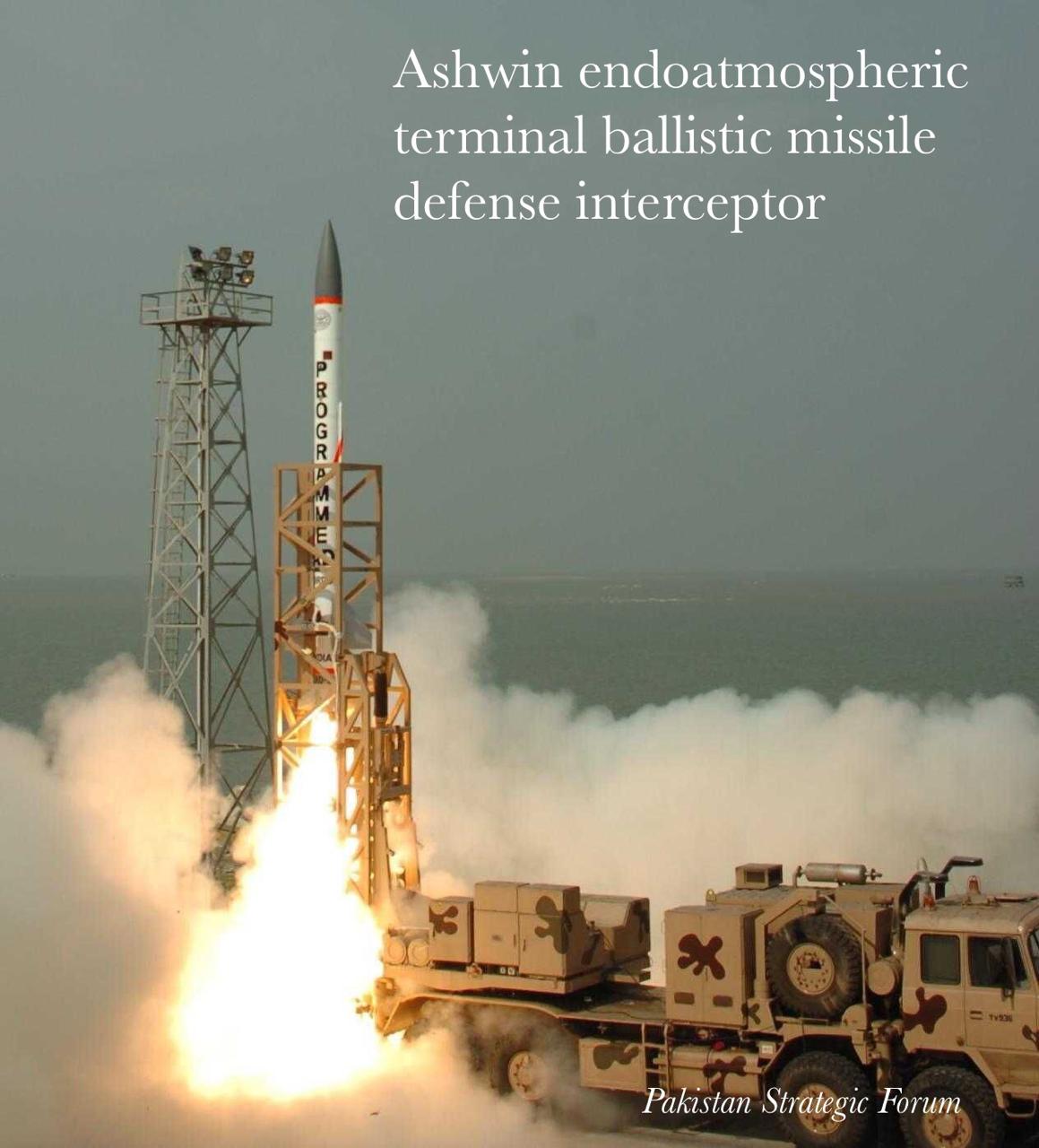
2. The other system is the Ashwin endoatmospheric ballistic missile defense system to intercept missiles that have already entered the atmosphere at an altitude of 20-30 kms. The single stage 7.5 metre tall solid fuelled missile can be kept at standby for extended periods of time, increasing its efficacy. It has a declared range of 200-250 kms. It also has active radar guidance in its terminal phase.
The radar that the Indians use for tracking enemy ballistic missiles is the Swordfish Long Range Tracking Radar (LRTR) developed by DRDO as a more powerful derivative of the Israeli EL/M-2080 Green Pine ground-based missile defense radars which India acquired in 2005.
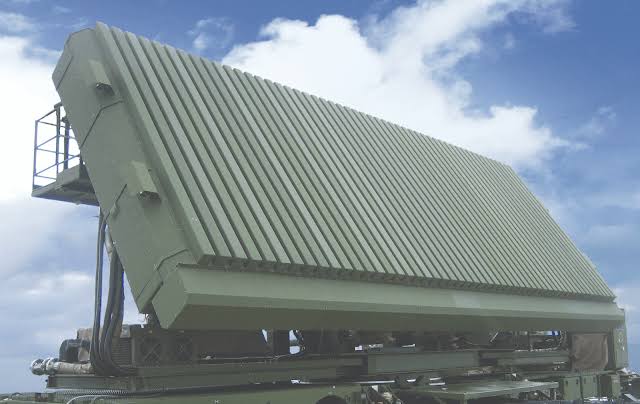
Swordfish LRTR
The Active Electronically Scanned Array (AESA) long range tracking radar has been designed specifically for ballistic missile detection in its boost phase as it rises through the atmosphere at high speeds. While most of the hardware used in the radar is Israeli some components such as the TRMs and computers are of Indian origin and has a reported range of 600-1500 kms. The radar acts as both the tracking and fire control radar and has been extensively tested as successful by Indian strategic forces. Another radar used is the indigenous Medium-Power Radar Arudhra, which is a 4D rotating phased-array radar. It has a 300 km range for detecting at altitudes of 100 meters to 80 kilometres India also uses original Israeli Green Pine radars as a back-up as well as a newer EL/M-2090 TERRA S-band SPECTRA radar, also of Israeli origin. India has 5 BMD Radar sites, out of which 1 is apparently abandoned, 3 are operational and 1 is under-construction. Satellite imagery accessed by PSF/WhiskeyPapa is available.
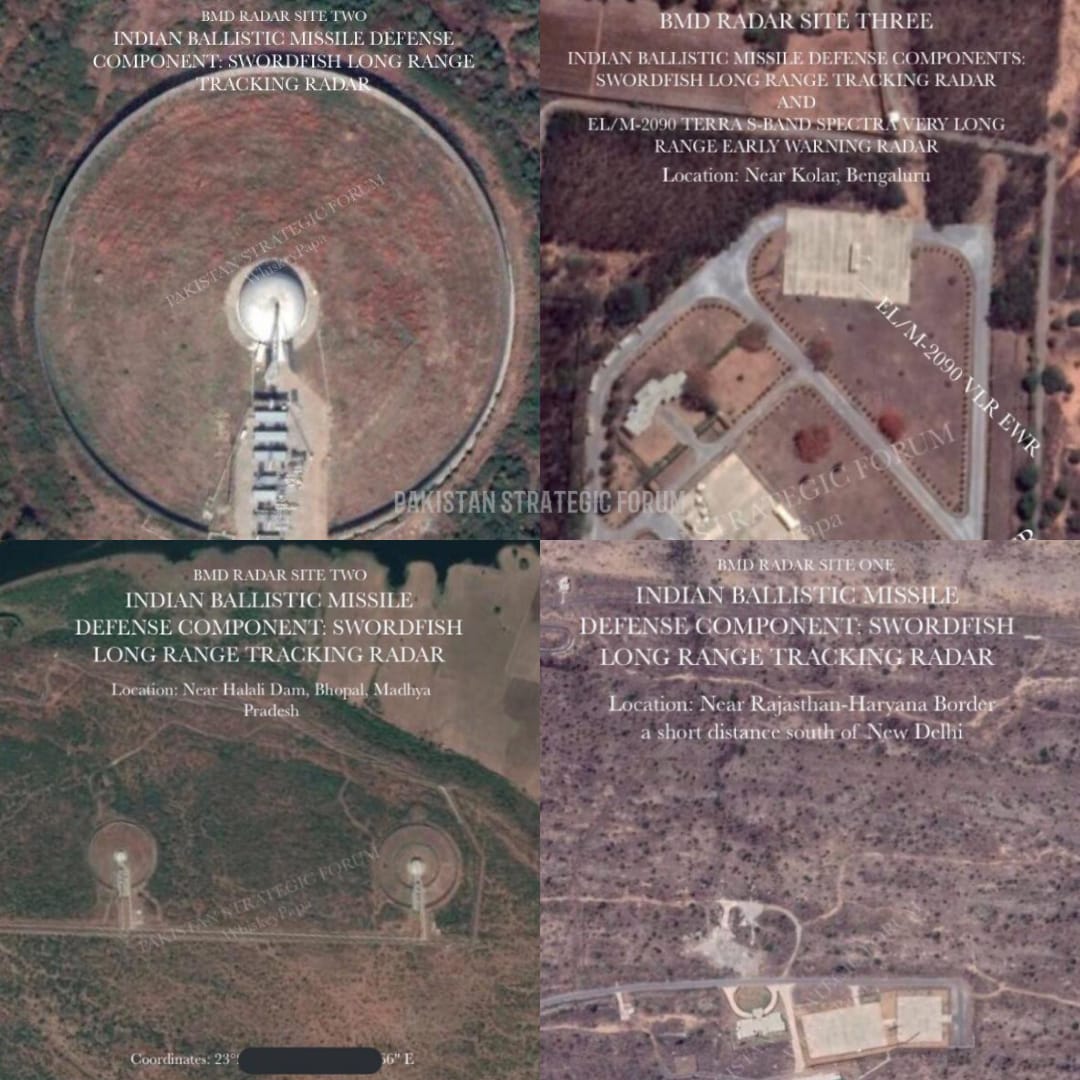
Indian BMD Sites
PAKISTANI BMD COUNTERMEASURES
[NOTE: Pakistani missile technology is highly classified. Neither PSF nor the writer #WhiskeyPapa is claiming to have any accurate idea of what exact BMD countermeasures Pakistani strategic forces employ. Nevertheless, both ISPR and Pakistani scientists have reported extensively that Pakistani missiles do employ extensive BMD countermeasures and are designed to counter extreme ballistic missile hostile environments]
Both these Indian BMD systems employ hit-to-kill interception would have less than 30 seconds (less than 18 in case of the Ashwin) to track and fire at tens of Pakistani decoys and warheads travelling at Mach 20+ speeds.
The sites of the early warning, tracking and fire-control radars (all of which are Israeli designed radars) which the BMD systems use are known to Pakistani forces (they are based on the Rajasthan-Haryana border, another near Bhopal, Madhya Pradesh and another in Bengaluru) and would probably be targeted by anti radiation missile air strikes or cruise missile strikes (using both nuclear or HE warheads).
The Indian interception missiles themselves feature old BMD designs, abandoned by the Americans and Russians in the early 1990s as obsolete. The Indian programs themselves have been plagued with technological problems for several years. Another program known as the Akash system for missile defense and SAM role was developed but was rejected by the Indian armed services because of a high failure rate, excessive system malfunctions and falling short of the required velocity.
Pakistan has various methods, some already in operation and some in the testing phase and others still on the drawing board, that would effectively counter India’s rudimentary but real BMD capabilities and thus arrest any shift in strategic stability.
Numbers wise, it has been estimated by experts at MissileThreat.Org and IISS that India would be able to (theoretically) successfully intercept 15% of missiles headed its way. And that too over only it’s most important strategic assets and cities and New Delhi. Although this percentage can be further decreased by using mid-course decoys such as used in the Shaheen series of MRBMs, the most effective way however, is the use of multiple independently targetable reentry vehicle (MIRV) technology which has multiple nuclear warheads on one single missile, each of which can be targeted at several different locations or one location thus confusing BMD radars where the warheads might fall until it is too late to intercept as well as making it harder to intercept all of them separately.

MIRVs with Inflation Decoys
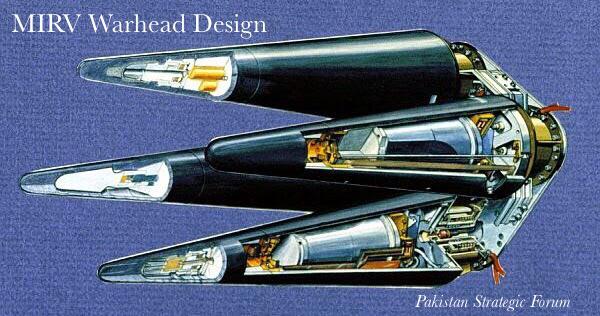
MIRV and MRV (instead of single warhead missiles) themselves largely improve penetration since there are many more warheads to destroy than missiles, which may saturate the defensive system’s stock of weapons. However, these technologies are very demanding since they require the ability to highly miniaturize both the physics package inside, as well as including the warheads themselves and, for MIRVed warheads, to master the art of accurately dispensing each warhead and possibly other payload elements (penetration aids, etcetera.) in what is often designated as the post-boost phase or payload deployment phase.
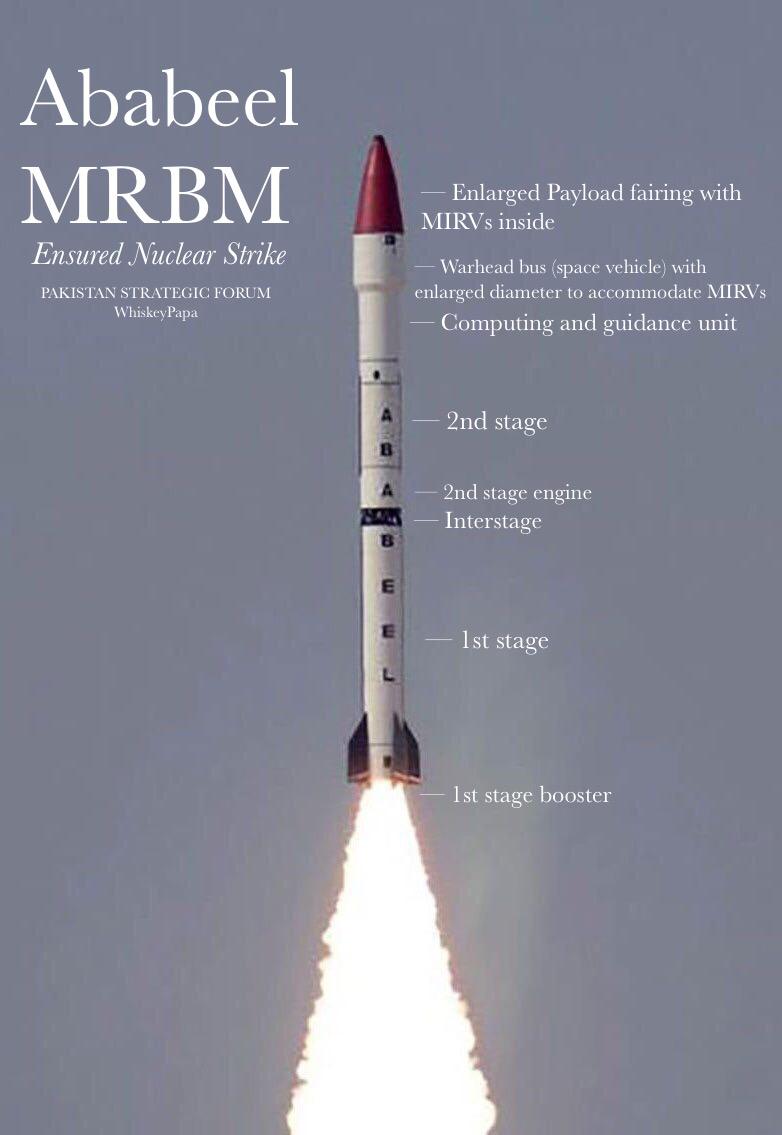
Securing a strategic site from a nuclear strike would become very hard if 8 warheads are coming your way simultaneously. This system is present with Pakistan in the form of the Ababeel MIRV nuclear missile (MIRV Ababeel bus consists of three standard warheads of 500 kg each or 5 warheads of 300 kg or 8 maximum warheads weighing 185 kg) making Pakistan the only country in South Asia to have this capability.
By
Admin PSF
August 27, 2020
https://vk.com/share.php?url=https:...issile-defense-and-pakistani-countermeasures/

Indian Ballistic Missile Defense
>Ballistic Missile Defense encompasses all efforts employed to stop a tactical or strategic attack by a ballistic missile, but usually BMD is concerned with missiles armed with nuclear weapons.

Anti-Ballistic Missile Defense System
>A ballistic missile is a missile which follows a ballistic trajectory (i.e. is propelled via rocket to very high speeds for a short time such that it leaves the atmosphere, makes an arch and follows a suborbital trajectory in space and then falls back to earth and hits the target).

Ballistic Missile Flight Phases

>BMD countermeasures are incorporated in those ballistic missiles which are designed to penetrate a ballistic missile-hostile environment and these counter, fool, and target BMD systems to ensure nuclear payload delivery.
India has over the past two decades invested heavily in both procuring BMD systems as well as significant investments in the research & development of various indigenous ballistic missile defense systems in an attempt to deploy a layered BMD system so that a Pakistani nuclear strike could be deterred, denied or destroyed. This tips the strategic balance in the region.
The whole aim of strategic balance and parity is to ensure nuclear deterrence and a deterrent for war. Thus if you show any weaknesses in your nuclear deliverance systems the enemy might be emboldened to strike you first, if they believe you won’t strike back/won’t be able to strike back/your strike can be stopped by BMD. India has over the past years tried several times to shift the strategic balance in their own favour. Pakistan has always responded overwhelmingly effectively and has tried to keep the strategic balance in check.

BMD Interceptor
Even after significant investments in the range of billions of dollars and over 2 decades India has been unable to deploy even rudimentary Ballistic Missile Defense.
The Interception and destruction of an incoming ballistic missile warhead from space has been a field of interest throughout the cold war with the two world superpowers at the time (USSR & USA) developed and deployed many different types of BMD systems with various levels of success, none of them guaranteed. As the reentry vehicle carrying a nuclear warhead travels at Mach 20-25 and there are mere seconds between reentry and detonation.
The three different types of BMD systems target the ballistic missile in its three phases of flight- the boost phase (warhead is flying to space on a ballistic trajectory via a missile’s rocket engine), the midcourse phase (the warhead has separated from the main missile body and is cruising through space) and the terminal phase (warhead is falling down the path to its target and is reentering the atmosphere at speeds approaching Mach 23).
Targeting the missile in its boost phase is unfeasible as you would need to get close to the launch platform which is probably deep inside enemy territory.

YAL-1 Airborne Laser Weapon System

Mid-course interception is relatively easier but more susceptible to deception measures as modern missiles employ various decoys shaped like the warhead and also have various other countermeasures (explained below). The midcourse interceptor missiles are much heavier (as they have to carry a kill vehicle into space), more technologically complex and very expensive to build and maintain. While most BMD systems are ground-based, the Americans have developed the Aegis Defense System which is a ship-based missile defense system and is a mid-course interceptor for medium range missiles, although the ship must be in the right azimuth, range and location.

Terminal phase interception has from the start been identified as the most feasible method thus far and the Americans and Russians have designed various terminal interception missiles, starting from interceptor missiles with nuclear warheads themselves that detonated near the warheads and destroyed them and then moved on to standard High Explosives, tungsten rods or hit-to-kill technology (kinetic kill: striking the warhead with an object at high relative velocity, thus destroying it) as interception technology got better.

RIM-161 Ballistic Missile Interceptor
But, even the best interception missiles available today in the world have only a 52% chance of interception. The American NORAD command therefore advises firing 3-4 interceptors for every ballistic warhead heading its way. Even still, the effectiveness of these systems is debatable even after the US has spent over half a trillion dollars and 40+ years trying.
The BMD concept itself is flawed because of the numbers game. Interceptors are much more expensive, technologically complex and hard to maintain and operate than ICBMs/IRBMs/MRBS/SRBMs/TBMs and you need 4 for each and even then interception is not fully garaunteed. This is the reason why USSR & USA built thousands of nuclear bombs and missiles during the cold war as it was not feasible for even a world superpower to make and deploy such numbers of BMD interceptors.
India, however, neither has the amount of interceptors nor the technological superiority of either American or Russian BMD systems.
India has just begun work on a mid-course interception missile based on its anti satellite missile test which occurred last year, but this system would be very expensive, difficult to develop and will take at least 15-20 years to operationalise and would still be unfeasible, unpractical, expensive and in too low numbers for any real deterrence.
INDIAN BMD
India currently has two different BMD terminal interception systems in testing after its bid to acquire the Arrow-2 BMD systems from Israel was vetoed by Washington in 2002.
Both systems are designed by the Indian Defense Research and Development Organization (DRDO).
These systems are namely the Prithvi system and the Ashwin system which started development in 1999 and may come into operation in 2024, both to be employed in small numbers around the Indian capital of New Delhi and the surrounding strategic assets.
The two-tiered ballistic missile defense system consists of the

1. Prithvi exoatmospheric BMD system which would be tasked with terminal interception outside the atmosphere at a maximum 80 kilometres altitude. The 9.4 meter long missile has a gimballed directional warhead. This is a two stage liquid fuelled missile (thus cannot be kept ready at all times, which is a major disadvantage). The declared range is 300-2000 km. The missile warhead has active radar guidance in its terminal phase (which can be thwarted by ECM measures). The missile has cold gas thrusters to provide lateral movement during terminal manoeuvres and is claimed to have an acceleration fast enough to hit intermediate range ballistic missiles. After exiting the atmosphere, the missile jettisons it’s heat shield and engages its infrared seeker. The missile utilises a trajectory optimization system that enables the missile to intercept both high altitude and low altitude threats.

2. The other system is the Ashwin endoatmospheric ballistic missile defense system to intercept missiles that have already entered the atmosphere at an altitude of 20-30 kms. The single stage 7.5 metre tall solid fuelled missile can be kept at standby for extended periods of time, increasing its efficacy. It has a declared range of 200-250 kms. It also has active radar guidance in its terminal phase.
The radar that the Indians use for tracking enemy ballistic missiles is the Swordfish Long Range Tracking Radar (LRTR) developed by DRDO as a more powerful derivative of the Israeli EL/M-2080 Green Pine ground-based missile defense radars which India acquired in 2005.

Swordfish LRTR
The Active Electronically Scanned Array (AESA) long range tracking radar has been designed specifically for ballistic missile detection in its boost phase as it rises through the atmosphere at high speeds. While most of the hardware used in the radar is Israeli some components such as the TRMs and computers are of Indian origin and has a reported range of 600-1500 kms. The radar acts as both the tracking and fire control radar and has been extensively tested as successful by Indian strategic forces. Another radar used is the indigenous Medium-Power Radar Arudhra, which is a 4D rotating phased-array radar. It has a 300 km range for detecting at altitudes of 100 meters to 80 kilometres India also uses original Israeli Green Pine radars as a back-up as well as a newer EL/M-2090 TERRA S-band SPECTRA radar, also of Israeli origin. India has 5 BMD Radar sites, out of which 1 is apparently abandoned, 3 are operational and 1 is under-construction. Satellite imagery accessed by PSF/WhiskeyPapa is available.

Indian BMD Sites
PAKISTANI BMD COUNTERMEASURES
[NOTE: Pakistani missile technology is highly classified. Neither PSF nor the writer #WhiskeyPapa is claiming to have any accurate idea of what exact BMD countermeasures Pakistani strategic forces employ. Nevertheless, both ISPR and Pakistani scientists have reported extensively that Pakistani missiles do employ extensive BMD countermeasures and are designed to counter extreme ballistic missile hostile environments]
Both these Indian BMD systems employ hit-to-kill interception would have less than 30 seconds (less than 18 in case of the Ashwin) to track and fire at tens of Pakistani decoys and warheads travelling at Mach 20+ speeds.
The sites of the early warning, tracking and fire-control radars (all of which are Israeli designed radars) which the BMD systems use are known to Pakistani forces (they are based on the Rajasthan-Haryana border, another near Bhopal, Madhya Pradesh and another in Bengaluru) and would probably be targeted by anti radiation missile air strikes or cruise missile strikes (using both nuclear or HE warheads).
The Indian interception missiles themselves feature old BMD designs, abandoned by the Americans and Russians in the early 1990s as obsolete. The Indian programs themselves have been plagued with technological problems for several years. Another program known as the Akash system for missile defense and SAM role was developed but was rejected by the Indian armed services because of a high failure rate, excessive system malfunctions and falling short of the required velocity.
Pakistan has various methods, some already in operation and some in the testing phase and others still on the drawing board, that would effectively counter India’s rudimentary but real BMD capabilities and thus arrest any shift in strategic stability.
Numbers wise, it has been estimated by experts at MissileThreat.Org and IISS that India would be able to (theoretically) successfully intercept 15% of missiles headed its way. And that too over only it’s most important strategic assets and cities and New Delhi. Although this percentage can be further decreased by using mid-course decoys such as used in the Shaheen series of MRBMs, the most effective way however, is the use of multiple independently targetable reentry vehicle (MIRV) technology which has multiple nuclear warheads on one single missile, each of which can be targeted at several different locations or one location thus confusing BMD radars where the warheads might fall until it is too late to intercept as well as making it harder to intercept all of them separately.

MIRVs with Inflation Decoys

MIRV and MRV (instead of single warhead missiles) themselves largely improve penetration since there are many more warheads to destroy than missiles, which may saturate the defensive system’s stock of weapons. However, these technologies are very demanding since they require the ability to highly miniaturize both the physics package inside, as well as including the warheads themselves and, for MIRVed warheads, to master the art of accurately dispensing each warhead and possibly other payload elements (penetration aids, etcetera.) in what is often designated as the post-boost phase or payload deployment phase.

Securing a strategic site from a nuclear strike would become very hard if 8 warheads are coming your way simultaneously. This system is present with Pakistan in the form of the Ababeel MIRV nuclear missile (MIRV Ababeel bus consists of three standard warheads of 500 kg each or 5 warheads of 300 kg or 8 maximum warheads weighing 185 kg) making Pakistan the only country in South Asia to have this capability.



